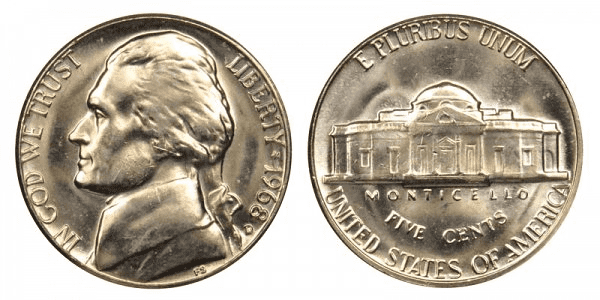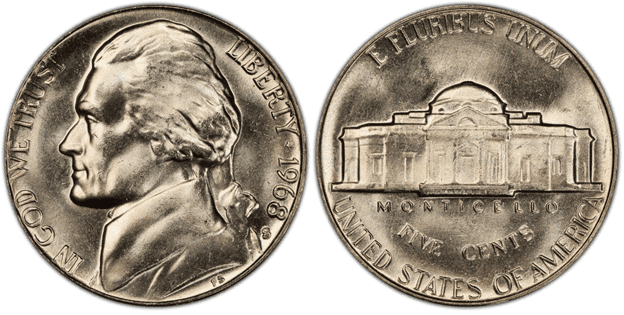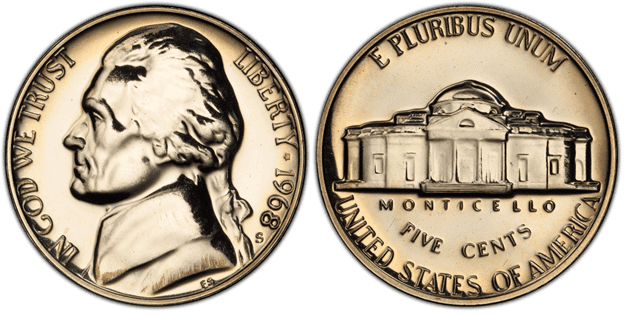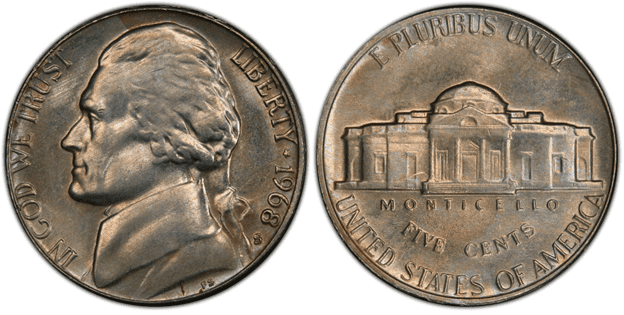What Is A 1968 Jefferson Nickel Made Of?
Comprised of 75% Copper, 25% Nickel the Jefferson Nickel was produced from 1938-2003. On October 3, 1938, the US mints produced the first Jefferson coins. Schlag was chosen before other designers to create the renowned coin because they desired a design featuring Thomas Jefferson’s likeness and his mansion.
Nickel was a crucial component utilized at the time to create weaponry like the armored tanks employed in the First World War. As a result, nickel and Jefferson nickel coins were widely hoarded.
The US Congress created a policy to reduce the amount of nickel in Jefferson’s currency as a temporary solution to regulate the level of nickel production. Therefore, to create Jefferson coins, the US mints used a copper, manganese, and silver alloy.
The obverse of the coin has a portrait of Thomas Jefferson looking to the left. The words “IN GOD WE TRUST” are printed in block letters around the left rim, in front of the president’s picture. Along the right border behind the photo, the word “LIBERTY” is written in block letters as an additional description. After the word “LIBERTY,” on the obverse face, is the year of mintage.
The front elevation of the president’s well-known mansion is depicted in the coin’s center on the reverse of the original design. The word “MONTICELLO” is written in block letters and straight lines below the home. The denominational value of the coin lies slightly below the house and is curvedly printed as “FIVE CENTS.”
Along the upper rim of the coin are the words “E PLURIBUS UNUM,” and along the lower rim are the words “UNITED STATES OF AMERICA.”
In 1968 NASA’s Apollo 8 was orbiting the moon and the inaugural flight of Boeing’s 747 jumbo aircraft occurred. The USS Pueblo, a Navy intelligence ship was sunk, and two peace activists, Martin Luther King Jr. and Robert F. Kennedy were assassinated.
1968 Jefferson Nickel Varieties
1968 Nickel With No Mint Mark
No 1968 Jefferson Nickels were minted in Philadelphia in this year, meaning that there aren’t any examples without the D (Denver) or S (San Francisco) mint marks.
1968 D Nickel
Year: 1968
Face Value: $0.5
Composition: 75% Copper, 25% Nickel
Total Weight: 5g
Diameter: 21.2 mm
Thickness: 1.75 mm
Edge: Plain
Minted in: Denver
Quantity Minted: 91,227,880

photo source: www.usacoinbook.com
1968 S Nickel
Year: 1968
Face Value: $0.5
Composition: 75% Copper, 25% Nickel
Total Weight: 5g
Diameter: 21.2 mm
Thickness: 1.75 mm
Edge: Plain
Minted in: San Francisco
Quantity Minted: 103,437,510

photo source: www.pcgs.com
1968 S-Proof
Year: 1968
Face Value: $0.5
Composition: 75% Copper, 25% Nickel
Total Weight: 5g
Diameter: 21.2 mm
Thickness: 1.75 mm
Edge: Plain
Minted in: San Francisco
Quantity Minted: 3,041,506

photo source: www.pcgs.com
List of Errors
There are no documented examples of widespread errors seen in the 1968 Jefferson Nickel, meaning that all errors are on a coin-by-coin basis. However, a factor which can impact how sought after your nickel is, is whether or not it has ‘full steps’ as seen in the image below:

photo source: www.pcgs.com
The Jefferson Nickels with at least five whole steps visible at the base of Monticello on the reverse are referred to as “Full Steps” circulation strikes. In general, the label is used to designate coins that have been fully struck. To be distinguished, there must be no deviation from the steps caused by weak strikes, contact marks, or planchet problems.
Because 1968 was a very poor year for mint quality, 1968 nickels with full steps are quite rare and in high demand.
How Much Is A 1968 Jefferson Nickel Worth Today?
1968 nickels have an intrinsic metal value of $0.0574, which is marginally more than the coin’s face value. This means that the coin’s worth is determined by the coin’s condition, provenance, mistakes, and other characteristics. A chart showing the values of 1968 nickels in various scenarios is provided below.
| Coin | G | VG | F | VF | MS60 | MS65 | PR |
| 1968-D | – | – | – | – | $0.28 | $5.70 | – |
| 1968-S | – | – | – | – | $0.28 | $5.70 | $4.62 |
How Does The Grading System Work?
The Sheldon Scale is used by numismatists to provide a numerical value to coins. The Sheldon Scale goes from poor (P-1) to perfect mint state (P-1) (MS-70). Coins were originally evaluated using words to reflect their condition (Good, Fair, Excellent, Etc.). Unfortunately, coin collectors and dealers had different ideas about what each of these terms represent.
Professional numismatists joined together in the 1970s and established CoinGrading standards. These numismatists now assign grades at key places on the seventy-point scale, using the most regularly utilized numeric points in conjunction with the original adjective grade. The following are the most common coin grades:
-
-
- (P-1) Poor – Indistinguishable and probably damaged; if used, must have a date and mintmark; otherwise, rather battered.
- (FR-2) Fair – Nearly smooth, but without the damage that a coin graded Poor often possesses. The coin must have enough detail to be identified.
- (G-4) Fair – Inscriptions have merged into the rims in some areas, and important elements have been mostly erased.
- (VG-8) Very Good- A little weathered, but all of the primary design elements are visible, albeit faintly. There is little if any, central detail left.
- (F-12) Good – The item is very worn, yet the wear is even, and the overall design details stand out clearly. Rims are almost completely isolated from the field.
- (VF-20) Very Fine – Moderately weathered, with some finer features still visible. The motto or all letters of LIBERTY are readable. Both sides of the coin have entire rims that are separated from the field.
- (EF-40) Extremely Fine – Gently used; all gadgets are visible, and the most important ones are bold. The finer details are bold and clear, however, light wear may be seen.
- (AU-50) Uncirculated – Slight evidence of wear on the coin’s design’s high points; may have contact marks; eye appeal should be adequate.
- (AU-58) Uncirculated Choice – Slight traces of wear, no severe contact marks, almost full mint shine, and great eye appeal.
- (MS-60) Mint State Basal – Strictly uncirculated; no indication of wear on the coin’s highest points, but an unsightly coin with reduced luster, visible contact marks, hairlines, and other flaws.
- (MS-63) Mint State Acceptable – Uncirculated, but with contact scratches and nicks, little reduced shine, but otherwise appealing appearance. The strike is weak to average.
- (MS-65) Mint State Choice – Uncirculated with great mint shine, very little contact blemishes, and exceptional eye appeal. The strike is unusually severe.
- (MS-68) Mint State Premium Quality – Uncirculated with superb luster, no obvious contact marks to the naked eye, and exceptional eye appeal. The strike is quick and appealing.
- (MS-69) Almost Perfect Mint State – Uncirculated with perfect brilliance, a sharp and appealing strike, and extremely good eye appeal. A near-perfect coin with minor imperfections in the planchet, strike, and contact markings (seen only under 8x magnification).
- (MS-70) Mint State Perfect – Under 8x magnification, there are no tiny imperfections discernible; the strike is crisp, and the coin is perfectly centered on a beautiful planchet. Rarely seen on a coin, this coin is bright and whole, with original luster and exceptional eye appeal.
-
Where To Buy Or Sell 1968 Nickels?
As we’ve learned in this article, most examples of 1968 nickel are worth little more than their face value, meaning that unless you’re looking to purchase one to finish a collection or for sentimental value, purchasing a Nickel for a few bucks from eBay isn’t really worth your time. As mentioned, the real value in these nickels comes from great condition and limited wear.
For examples such as ‘full steps’ variants, selling your Nickel at a recognized specialist auction house such as Heritage Auctions is a smart move.
FAQs
Where is the mint mark on a 1968 Jefferson nickel?
The Mint Mark on 1968 Nickels is found on the obverse side of the coin below the date.
Is a 1968 S nickel a proof?
Not all 1968 S nickels are proofs as San Franciso and Denver were responsible for striking all of the nickels created in this year. However, the San Francisco mint did strike 3,041,506 proof coins for this year.
How much does a 1968 nickel weigh?
A 1968 Nickel weighs exactly 5 grams.
What years are the most valuable Jefferson nickels?
There are a variety of valuable examples of Jerfferson nickel, most notably error varieties such as the 1971 proof that is missing its ‘S’ mint mark. The most valuable Jefferson Nickel is the 1964 (SMS) nickel, which in MS65 condition sold for $8,750 at auction.




